Halifax, West Riding of Yorkshire
Up to 1834
In 1635, Charles I granted Halifax a charter to set up a workhouse and a managing committee known as the "Master and Governors of the Workhouse for the poor, within the town and parish of Halifax." The workhouse was established near the parish church in a large house given by Nathaniel Waterhouse "to set the poor within the town and parish to work." Waterhouse was appointed the first master, his successors being elected every year by the twelve governors from among themselves. Most of the inmates were contracted out as hired labour.
A parliamentary report of 1777 recorded local workhouses in operation at Ealand [Elland] with Greetland (for up to 80 inmates), Halifax (100), Hipperholm with Brighouse (40), Midgley (24), Norland (12), Ovenden (40), North Owram (70), South Owram (60), Soyland (60), Stainland (50), and Warley (30).
Baines' Directory of 1830 records that the Halifax workhouse stood at 8 Upper Kirkgate, with Elizabeth Casson as its matron. The Overseers' Office was next door, at number 7, while a Vagrants' Office was located at 8 Copper Street.
Eden, in his 1797 survey of the poor in England, reported of Halifax that:
Southowram's workhouse dated back until at least the 1740s. It was situated on Ashday Lane where the name "Old Workhouse Quarry" was still current until at least the 1890s. Eden noted of the Southowram workhouse that:
Midgley's workhouse stood at New Heath Head at the end of Workhouse Lane to the north of Midgley .
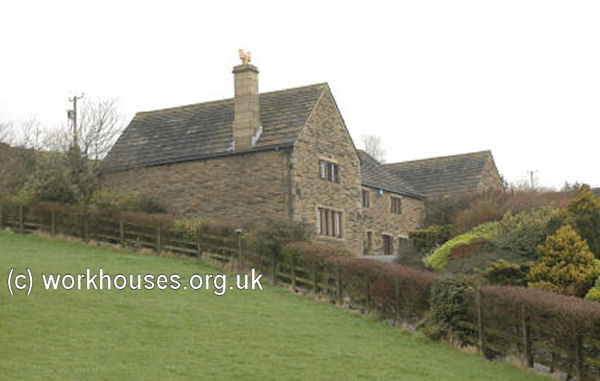
Midgley's former workhouse now renovated as a private house, 2006.
A house on Till Carr Lane in Brighouse was the workhouse for Hipperholme with Brighouse until 1834.
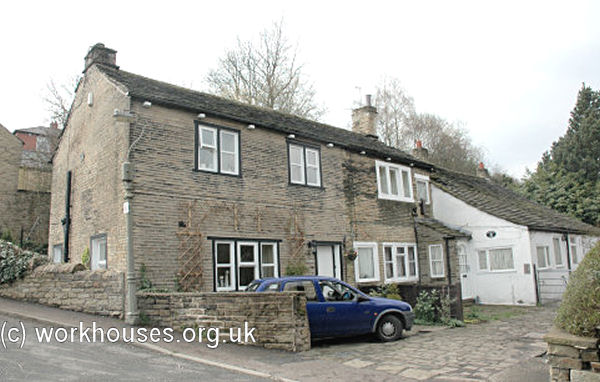
Brighouse former workhouse, 2006.
© Peter Higginbotham.
In Barkisland, a house on Scammonden Road was erected as the parish in 1827. A plaque over its door is inscribed: "This Building was erected AD 1827, by a Committee with the money arising from the coal in the White Birch Farm in Northow-ram, of which the interest that arises therefrom, is to be distributed to such poor people of Barkisland as have no Parochial Relief".
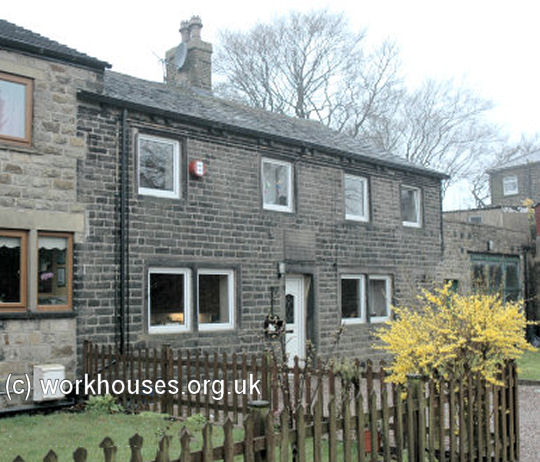
Barkisland former workhouse, 2006.
© Peter Higginbotham.
Sowerby had a workhouse at Bentley Royd on Sowerby New Road.
Stainland's workhouse was at the east side of Stainland Road as indicated on the 1854 map below.
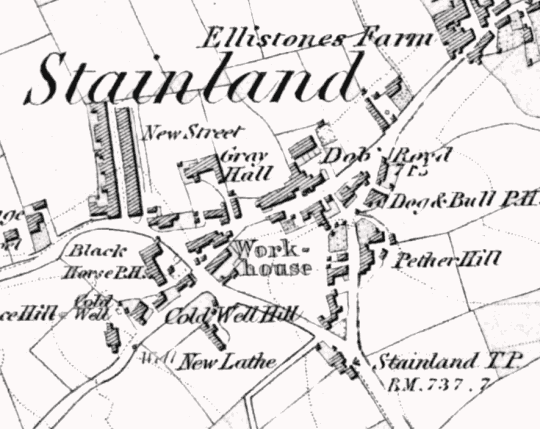
Stainland workhouse site, 1854.
The Elland and Greetland workhouse was at Hullenedge.
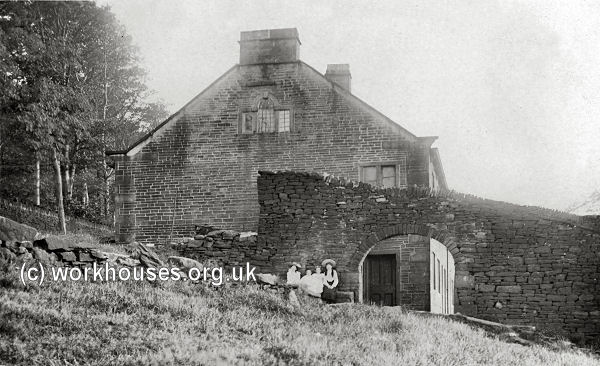
Elland and Greetland former workhouse.
© Peter Higginbotham.
A parliamentary report in 1834 recorded the workhouse populations in a number of Halifax townships:
| Workhouse | Inmates |
|---|---|
| Fixby | Two cottages housing 12 inmates |
| Elland cum Greetland | Total 34. 19 males (8 under 20, the others aged 60 to 70); 15 females (4 under 20, the others from 50 to 60) |
| Hipperholme cum Brighouse | 2 males aged 23 and 7, and 3 females aged 80, 63, and 37. |
| Midgley | 1 male aged 8, 2 females aged 10 and 7. |
| Northowram | Total 25. 8 under 10, 3 aged 10 to 30, 5 aged 30-60, 9 aged 60 to 90. 11 males 14 females. |
| Ovenden | Total 48. 5 under 10 years, 3 under 20, 2 under 30, 8 under 40, 12 under 60, 4 under 70, 10 under 80, and 4 under 90 |
| Shelf | No workhouse but a few small cottages belonging to the town inhabited by the poor, with a monthly allowance. |
| Skircoat | Total 10. 4 males (aged 76, 74, 68, and 30); 6 females (aged 74, 65, 28, 4, 3, and 1) |
| Southowram | Total 5. 2 females aged 72 and 62; 3 males aged 72, 46, and 43. |
| Sowerby | Total 34. 21 males: 5 under 10, 2 under 15, 3 under 20, 1 under 30, 2 under 40, 2 under 50, 1 under 60, 2 under 70, 3 under 80. 14 females: 4 under 10, 1 under 15, 1 under 20, 1 under 30, 4 under 40, 1 under 50, 1 under 60, 1 under 70. |
| Soyland | Total 12: 3 men aged about 80, 70, 23; 9 females aged about 80, 70, 70, 66, 60, 23, 22, 3 and ½ |
| Stainland | Total 13: 7 females aged from 1 to 60; 6 males from 8 to 78. |
| Warley | 11 inmates. |
After 1834
Halifax Poor Law Union was officially formed on 10th February 1837. Its operation was overseen by an elected Board of Guardians, 31 in number, representing its 19 constituent parishes/townships as listed below (figures in brackets indicate numbers of Guardians if more than one):
West Riding of Yorkshire:
Barkisland, Clifton with Hartishead [Hartshead], Elland with Greetland (2), Fixby, Halifax (5), Hipperholme with Brighouse (2), Midgley, Norland, Northowram (2), Ovenden (2), Rastrick, Rishworth, Shelf, Skircoat, Southowram (2), Sowerby (2), Soyland, Stainland and Old Lindley, Warley (2).
Later Additions (all from 1894): Luddenden Foot, Norwood Green and Coley, Queensbury, Sowerby Bridge, Upper Greetland.
The population falling within the Union at the 1831 census had been 89,739 with parishes/townships ranging in size from Fixby (population 348) to Halifax itself (15,382).
The Board of Guardians held their first meeting on 17th February, 1837, at the Trustees Office in Cheapside, Halifax. Those in attendance were: Mr. George Buckston Browne, Mr. Jonathan Akroyd, Mr. George Whiteley, Mr. Joseph Nicholson, Mr. James Hoatson (representing Halifax); Mr. John Stott jnr., Mr. Abraham Pitchforth (Elland Cum Greetland); Mr. John Wilson (Ovenden); Mr. Matthew Paterson, Mr. Thomas Barker (Southowram); Mr. John Holland, Mr. Joshua Butterworth (Hipperholme Cum Brighouse); Mr. Thomas Oldfield, Mr. Samuel Smith (Warley); Mr, John Foster, Mr. Robert Stansfeld (Sowerby); Mr. William Armytage (Clifton Cum Hartshead); Mr. George Binns (Norland); Mr. John Denton (Stainland With Old Lindley); Mr. George Beaumont, Mr. Josehh Stocks, Mr. Edward Emmet (Northowram); Mr. William Baxter (Berkisland); Mr. Walker Priestley (Soyland); Mr. Michael Hoyle (Rishworth); Mr. Charles Pitchfort (Rastrick); Mr. Thomas Gregory (Shelf); Mr. John Aked (Midgley). Skircoat (2 Members) And Fixby did not appear to have elected their representatives leaving the Board 3 members short. Mr. George Buckston Browne, Of Myrtle Grove, Halifax, was elected the first Chairman. Mr. George Binns was appointed Vice-Chairman. Mr. Charles Barstow, Solicitor, Halifax, was appointed Clerk to the Board.
Ninety-three years later, on March 31st, 1930, a dinner to mark the dissolution of the Board was given in the workhouse dining hall. A souvenir menu contained the following history of the Union.
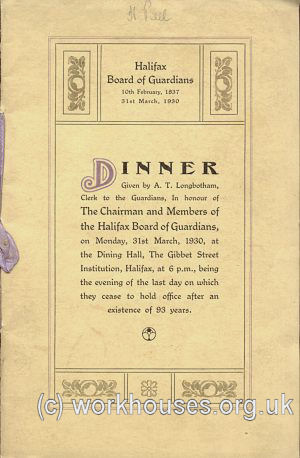
Souvenir menu, 1930
© Peter Higginbotham.
|
1838. Guardians considered reports on existing Workhouses. There were 14 Township Workhouses, viz.: at Halifax, Southowram, Hipperholme cum Brighouse, Rastrick, Elland cum Greetland, Stainland, Warley, Soyland, Sowerby, Northowram, Shelf, Ovenden, Skircoat and Norland. (Note.- There was certainly one also at Barkisland but it is not mentioned). 1839. On 27th July, Board decided to erect a new Workhouse for the Union. Land was bought between Gibbet Lane and Hanson Lane. Poor Law Commissioners had reported that in the Township Workhouses the number of inmates was 231. "Some of these houses (said the report) were in a state unfit for human beings to inhabit and the aggregate expense was very great." 15 District Medical Officers were appointed in February of this year. 1840. Removal of paupers from old Workhouses to new Workhouse. Fever Hospital to be forthwith erected at Workhouse "to be completely detached from Main Building." 1841. Period of considerable distress. Guardians had constant difficulty in dealing with applications for relief. In 1846 a large sum was raised by inhabitants for relief of the unemployed. It was used by putting men on the construction of a New Reservoir. The men were paid 2d. per hour. In 1849, £16,376 was expended in relief by the Guardians. Until the Charter of Incorporation was obtained for Halifax in 1849 the Guardians were the only elective public body in the Town and District. They had the duty of abating Nuisances under the Nuisances Removal Act. Between November 1848, and February 1851, they dealt with 1,597 Nuisances in Halifax. The Guardians had also to cope with Infectious Disease. In 1849 there was a severe epidemic of Cholera in the Town. 579 cases were diagnosed as Diarrhoea and 20 as Asiatic Cholera. It was stated by Dr. Alexander, a prominent medical man of the Town, "The house to house Visitation directed by the Guardians mitigated the severity and checked the fatality of the epidemic and the early preparation made by that Board in the way of nuisance removal and other preventive measures to all human appearance effectually met the approaching outbreak." During this period the Guardians were in actual fact the Public Health Authority for the Town of Halifax. In 1851 the Public Health Act 1848, was put in force in Halifax notwithstanding that it was strongly opposed by the Town Council. The duty of Public Health administration (which was foreign to the Guardians' constitution) was thereafter carried out by the Halifax Corporation. At this time there were 312 cellar dwellings in Halifax with 958 persons inhabiting them and apart from these, housing conditions generally were bad. These conditions had their reflex in the large sums the Guardians had to disburse in relief. Times, however, were more prosperous and the numbers obtaining relief began to decline. 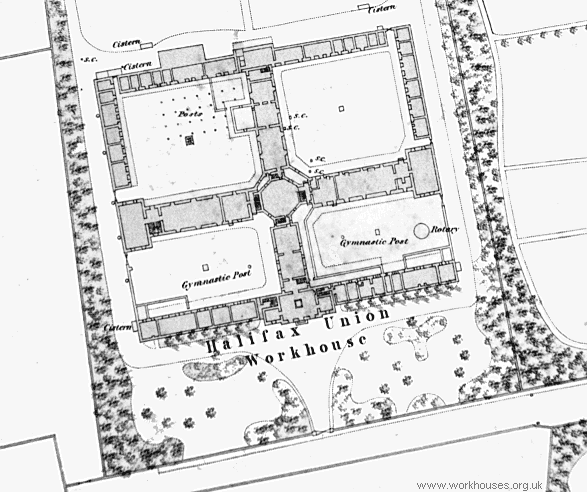
Halifax workhouse site, 1849. In 1869-70, two large 3-Storey Infirmary Pavilions were erected at the rear of the main buildings at a cost of £30,000. These wards were at that period "the last word" in Hospital construction. They did splendid work for the suffering poor until the erection of St. Luke's Hospital at the end of the Century. In 1872 the large Dining Hall (which was designated the "Dining Hall and Chapel") was built. A serious epidemic of Smallpox and Typhus Fever broke out in 1871-2. A large number of cases were treated by the Guardians in the "Back Block" at the Workhouse. The Halifax Corporation had no Hospital. They insisted that the Guardians were the "Sanitary Authority" and must provide Hospital treatment for the infected persons. The Local Government Board, however, very soon told the Corporation that they were the responsible authority and that Body had hurriedly to provide an emergency Hospital. In 1894 was passed the Local Government Act of that year. It abolished the open Voting System for Boards of Guardians and other Authorities, the Ballot superseding it. The Guardians had henceforth to be elected on the Township principle. The number was increased to 48. Women, previously disfranchised, were enabled to be elected to Boards of Guardians. At the election in December 1894, five ladies were for the first time elected Guardians. At this election, Mr. J. W. Hodgson (who first became a member 2 years previously), Mr. J. B. Carter and Mr. Wm. Haigh, were returned as Guardians. All three still remained Members in 1930. In 1897 the building of St. Luke's Hospital at Salterhebble began. Mr. W. C. Williams, the Architect, 1930. travelled extensively in this country and abroad to acquire ideas in Hospital construction, and the result was the magnificent building at Salterhebble. It was occupied in 1901. The Hospital is the Guardians crowning achievement. It cost £103,000 and there is not a penny owing on it. During the War it was occupied as a War Hospital. The Guardians' Medical Officer, Dr. J. F. Woodyatt, was created a Lieutenant Colonel and placed in Command. But though under Military Control the Guardians continued to provision it and supervise the Building and they did this with great success. Thousands of men passed through the Hospital during the Military occupation. Land to the West of the Hospital was purchased with forethought for future extensions. After the War, patients (who had been treated in the old Sick Wards of the Gibbet Street Institution —the old Workhouse) were re-transferred to the Hospital, and the Guardians resumed their ordinary administration. Normal times did not arrive as was expected. Unemployment and distress ensued. Demonstrations of the unemployed were frequent. Numbers marched to the precincts of the Board Room when the Guardians were sitting and demanded relief. Firmness, patience, and discretion met the situation, and gradually more settled conditions were restored.
In 1929 was passed the Local Government Act. It abolishes Boards of Guardians and transfers their functions to other Authorities on 1st April, 1930.
After 93 years of successful administration, the Guardians end their sphere of labour with a pauperism of 118 per 10,000 of the population, the lowest numbers in the West Riding of Yorkshire, and which contrast with 347 per 10,000 for London Unions and 261 per 10,000 as the average for the whole Country.
Their Institutions are at the highest point of efficiency and are entirely free from debt. |
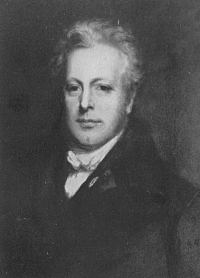
George Buckston Browne, |
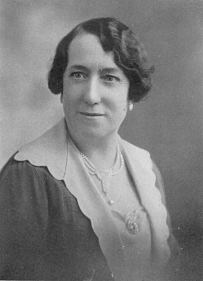
Miriam Lightfowler, JP, |
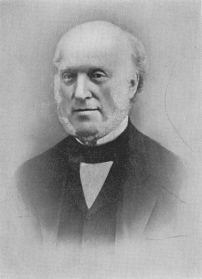
George Barstow, |
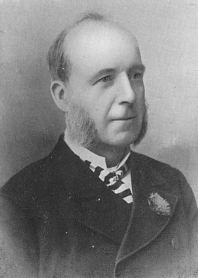
John William Longbottom, |
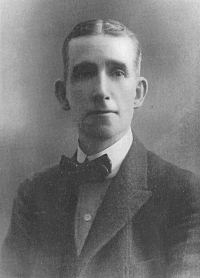
Arthur Thompson Longbotham, MBE, |
One episode that the above history omits occurred in 1842 when the Poor Law Commissioners investigated the employment and conditions of children in mines and manufactories. They discovered that workhouse boys, some as young as eight, were being sent on "apprenticeships" of up to twelve years working in coal mines. As a result, some unions in the coal-mining areas of South Staffordshire and the West Riding of Yorkshire were asked to provide detailed information on the children who had been apprenticed in the mining industry in recent years. The returns showed that small numbers of workhouse boys had indeed been sent to work in the mines although, no doubt chastened by the Commissioners criticism, most claimed that the practice had now ceased. The return for Halifax is included below. The first table lists boys under sixteen sent to work in coal mines or apprenticed to coal miners by the Halifax Union's Board of Guardians. In fact, in none of the cases was an apprenticeship arranged.
| Township | Name of Child | Age Yrs.Mos. | Coal mine. | Name of Master. |
|---|---|---|---|---|
| Southowram | William Hollingworth | 13—0 | Bradshaw Pit, Ovenden | Abraham Oldfield |
| Skircoat | John Pearson | 12—6 | Holling Edye, Elland | Joseph Whiteley |
| Sowerby | Joseph Firth | 13 | Shibden Pit, Nothowram | Thomas Bottomley |
| Halifax | Joseph Lister | 13 | Clough Hole Pit, Northowram | George Scott |
| Ditto | Joseph Ellis | 14—1 | Thorn Bar, Northowram | Ditto |
| Warley | William Wood | 15—0 | Windy Bank, Northowram | Joseph Burker |
| Ditto | ditto | " | Woodhead's Pit, Idle, near Bradford | Benjamin Normanton |
The second table lists boys who were sent to work in coal mines or apprenticed to coal miners by parish officers in the Halifax Union.
| Township | Name of Child | Age Yrs.Mos. | Apprenticed | Apprenticeship Period Yrs.Mos. | Premium. | Sent to work without being apprenticed. | Coal mine. | Name of Master. | |
|---|---|---|---|---|---|---|---|---|---|
| Elland Greetland | William Luty | 10—0 | yes | 11—0 | 20s. for clothing | no | Park Bottom, Elland | William Luty (boy's uncle) | |
| Ditto | Joseph Crossley | 9—0 | " | 12—0 | 20s. " | " | " | William Harewood | |
| Halifax | James Butterfield | 12—7 | " | 8—5 | none | " | Rawson's Collieries | Henry Butterfield (boy's brother) | |
| Ditto | Mark Chadwick | 10—0 | " | 11—0 | " | " | " | George Watson | |
| Ditto | Joseph Lister | 12—0 | " | 9—0 | " | " | Northowram Collieries | George Scott | |
| Hipperholme | Matthew Pender | 10—0 | " | 11—0 | " | " | Bradshaw, Ovenden | ||
| Ditto | John Brook | 14—2 | " | 6—10 | " | " | Pump, Southowram | ||
| Ditto | William Brook | 11—4 | " | 9—8 | " | " | ditto | ||
| Ditto | Charles Pinder | 11—0 | " | 10—0 | " | " | Bradshawhead, Thornton, near Bradford | ||
| Northowram | Alfred Saville | 9—2 | " | 10—2 | 15s. for clothing | " | Boothtown, Northowram | ||
| Ditto | William Sharp | 13—5 | " | 7—7 | 15s. " | " | Boothtown, Northowram | ||
| Ditto | Simeon Jowett | 9—9 | " | 11—3 | 15s. " | " | Bradshaw Lane, Ovenden | ||
| Ditto | James Noble | 11—0 | no | none | none | yes | Penfold Pit, Northowram | ||
| Ovenden | Shadrack Holden | 12—0 | yes | 9—0 | 10s. for clothing | no | Shugden Pit — ditto | ||
| Ditto | John Priestley | 10—3 | " | 10—9 | 10s. " | " | ditto | ||
| Stainland | James Ramsden | 11—4 | " | 9—4 | 10s. " | " | Shitlington, near Dewsbury | William Goldthorp |
William Hollingworth (or Hollingsworth), who appears in the first table above, later gave evidence to the 1842 Royal Commission on Children's Employment in Mines and Manufactories revealing how he had had to work underground continuously for up to sixteen hours a day:
(Signed) WILLIAM HOLLINGSWORTH.
As noted earlier, the Halifax Union workhouse was erected in 1839-40 at the north side of Gibbet Street at the west of Halifax. The architect is unknown. The site layout is shown on the 1905 map below.
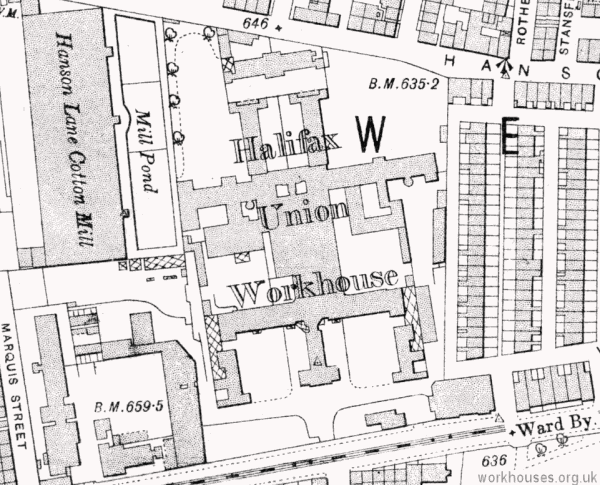
Halifax workhouse site, 1905.
With its entrance at the south, the main building was broadly based on the popular cruciform plan with four wings radiating from an octagonal hub. Originally there was a fever hospital at the rear with infirmary blocks to each side. This was the part of the building was redeveloped in 1869 with the creation of two new pavilion ward blocks and a fever ward to the north. The old infirmaries were converted for use by imbeciles and a small circular padded cells were added to the south side of each. New vagrant wards were erected at the west of the workhouse in 1895.
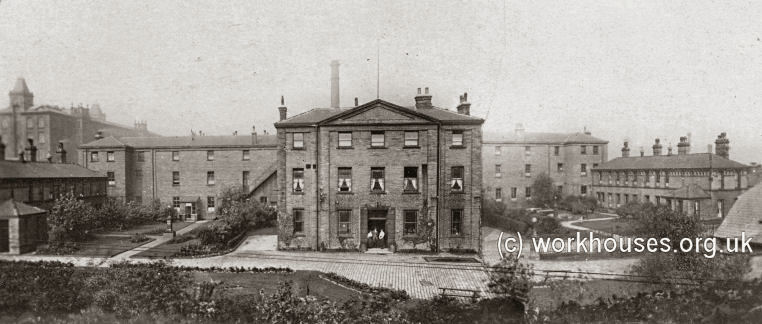
Halifax workhouse from the south, c.1919.
© Peter Higginbotham.
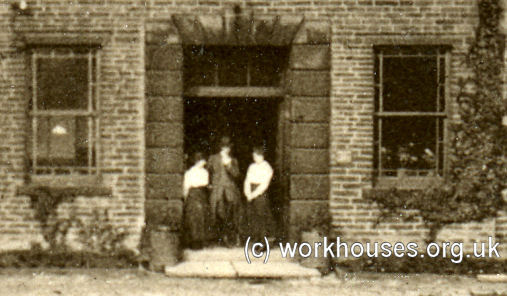
Halifax workhouse detail, c.1919.
© Peter Higginbotham.
In around 1905, a new porter's loage was erected on Gibbet Street.
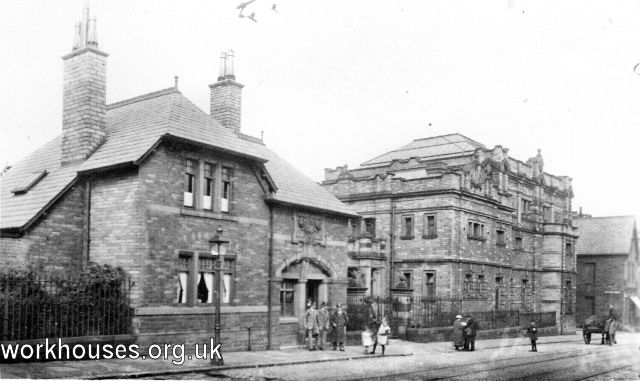
Halifax workhouse new porter's lodge (left), c.1905.
© Peter Higginbotham.
The workhouse site later became known as St John's Public Assistance Institution, and remained in use as an old people's home until 1949. The workhouse buildings no longer exist.
Halifax Union Infirmary
In 1897-1901, a new union infirmary was erected at Skircoat. As well as the usual long 'nightingale' wards, the new infirmary was unusual in having two three-storey circular tower wards similar to those in the poor law infirmaries at Hampstead and Camberwell. A full description of the buildings appeared in the journal The Builder in April 1901:
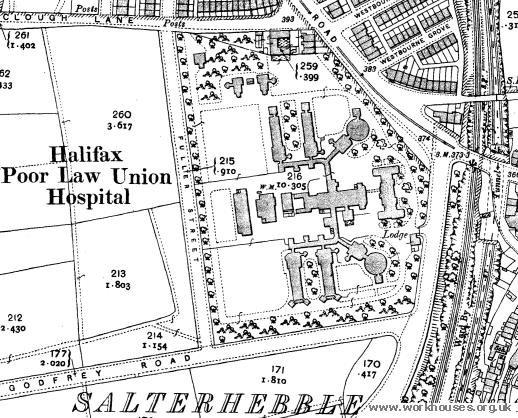
Halifax workhouse infirmaty site, Salterhebble, c.1905.
Between 1914 and 1920 the infirmary was occupied as St Luke's Military Hospital.
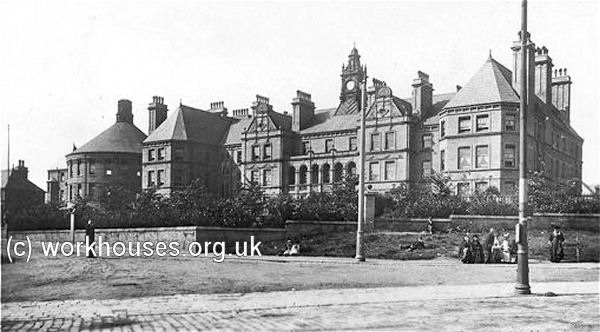
St Luke's Military Hospital c.1916.
© Peter Higginbotham.
In 1930, the infirmary site taken over by Halifax County Borough and became St Luke's Hospital, then after 1948 it joined the National Health Service as Halifax General Hospital. The surviving buildings now form part of the Calderdale Royal Hospital complex.
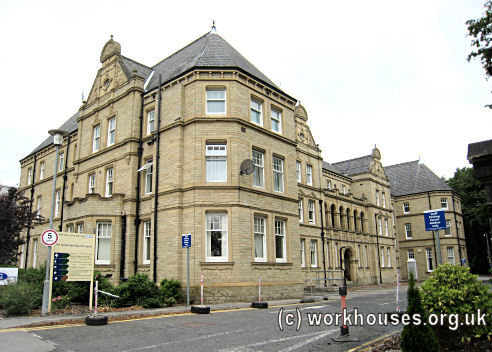
Nurses' home, 2009.
© Peter Higginbotham.
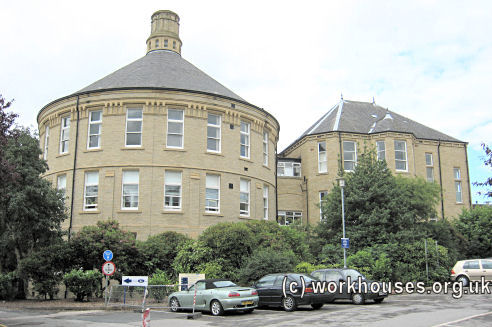
Infirmary circular ward block, 2009.
© Peter Higginbotham.
Children's Home
The Halifax Union operated a children's home at Craigie Lea, Ovenden. In 1924, the home could accommodate 34 children, with Miss Dyke as its superintendent.
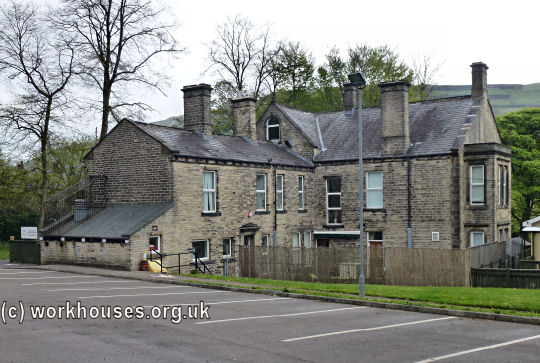
Craigie Lea, 2013. © Peter Higginbotham.
After 1930, the home was taken over by Halifax Borough Council as a home for 'low grade mentally defective boys and girls' up to the age of 14. The property is now a day nursery.
Staff
Inmates
Records
Note: many repositories impose a closure period of up to 100 years for records identifying individuals. Before travelling a long distance, always check that the records you want to consult will be available.
- West Yorkshire Archive Service (Calderdale Office), Central Library, Northgate House, Northgate, Halifax HX1 1UN. Relatively few records survive — holdings include: Settlement, apprenticeship and bastardy papers (1673-1749); Guardians' minute books (1837-41); Ledgers (1835-39, 1857-1925); etc.
Bibliography
Links
- Ripon Workhouse Museum and Garden, Sharow View, Allhallowgate, Ripon HG4 1LE.
Unless otherwise indicated, this page () is copyright Peter Higginbotham. Contents may not be reproduced without permission.


